Analysis of International Resourcing and Talent Planning at Starbucks
VerifiedAdded on 2023/01/11
|9
|2564
|94
Report
AI Summary
This report delves into the international resourcing and talent planning strategies of Starbucks, a multinational coffeehouse company. It explores the key factors influencing workforce planning, including government policies, economic conditions, social factors, technology, environmental concerns, and legal aspects, analyzed through a PESTLE framework. The report also examines internal factors such as organizational policies, strategies, production levels, and company life cycle stages. Furthermore, it investigates the key aspects of talent management practices at Starbucks, focusing on age, education, salary, benefits, working environment, job satisfaction, and security. The report utilizes the integrated talent management model (Acquire, Assess, Develop, Deploy) to illustrate Starbucks' approach to attracting, evaluating, developing, and retaining talent, emphasizing the importance of creating a positive working environment and aligning individual goals with organizational objectives.
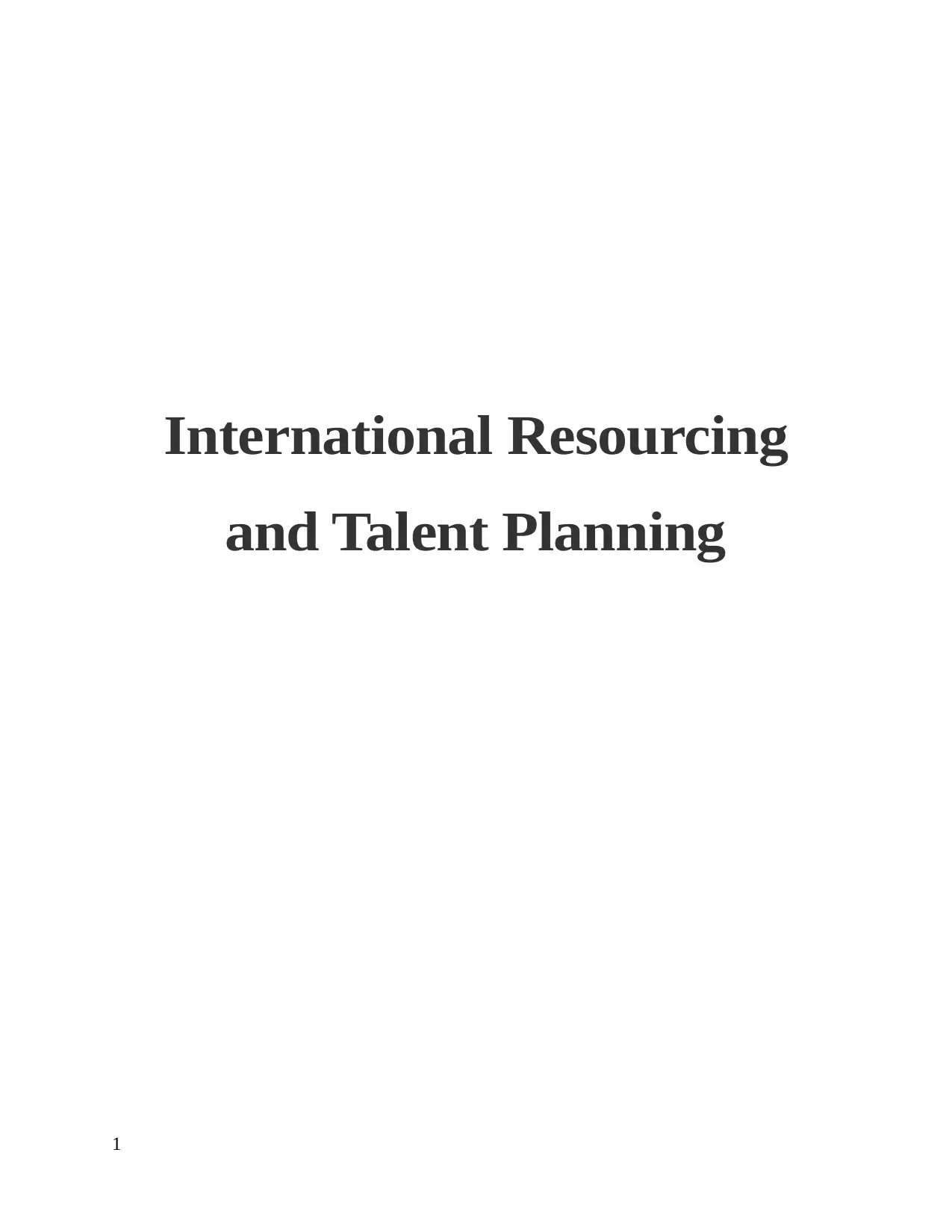
International Resourcing
and Talent Planning
1
and Talent Planning
1
Paraphrase This Document
Need a fresh take? Get an instant paraphrase of this document with our AI Paraphraser
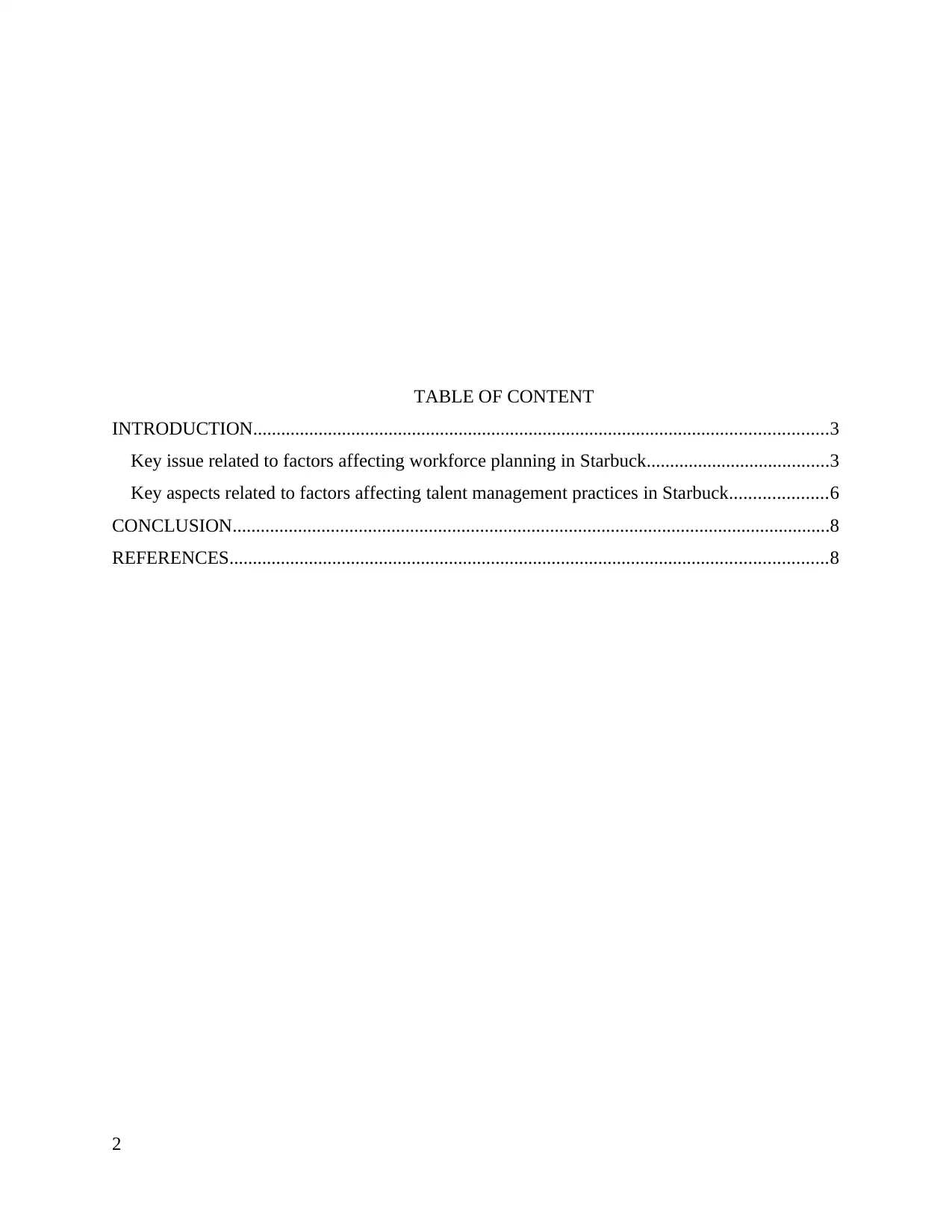
TABLE OF CONTENT
INTRODUCTION...........................................................................................................................3
Key issue related to factors affecting workforce planning in Starbuck.......................................3
Key aspects related to factors affecting talent management practices in Starbuck.....................6
CONCLUSION................................................................................................................................8
REFERENCES................................................................................................................................8
2
INTRODUCTION...........................................................................................................................3
Key issue related to factors affecting workforce planning in Starbuck.......................................3
Key aspects related to factors affecting talent management practices in Starbuck.....................6
CONCLUSION................................................................................................................................8
REFERENCES................................................................................................................................8
2
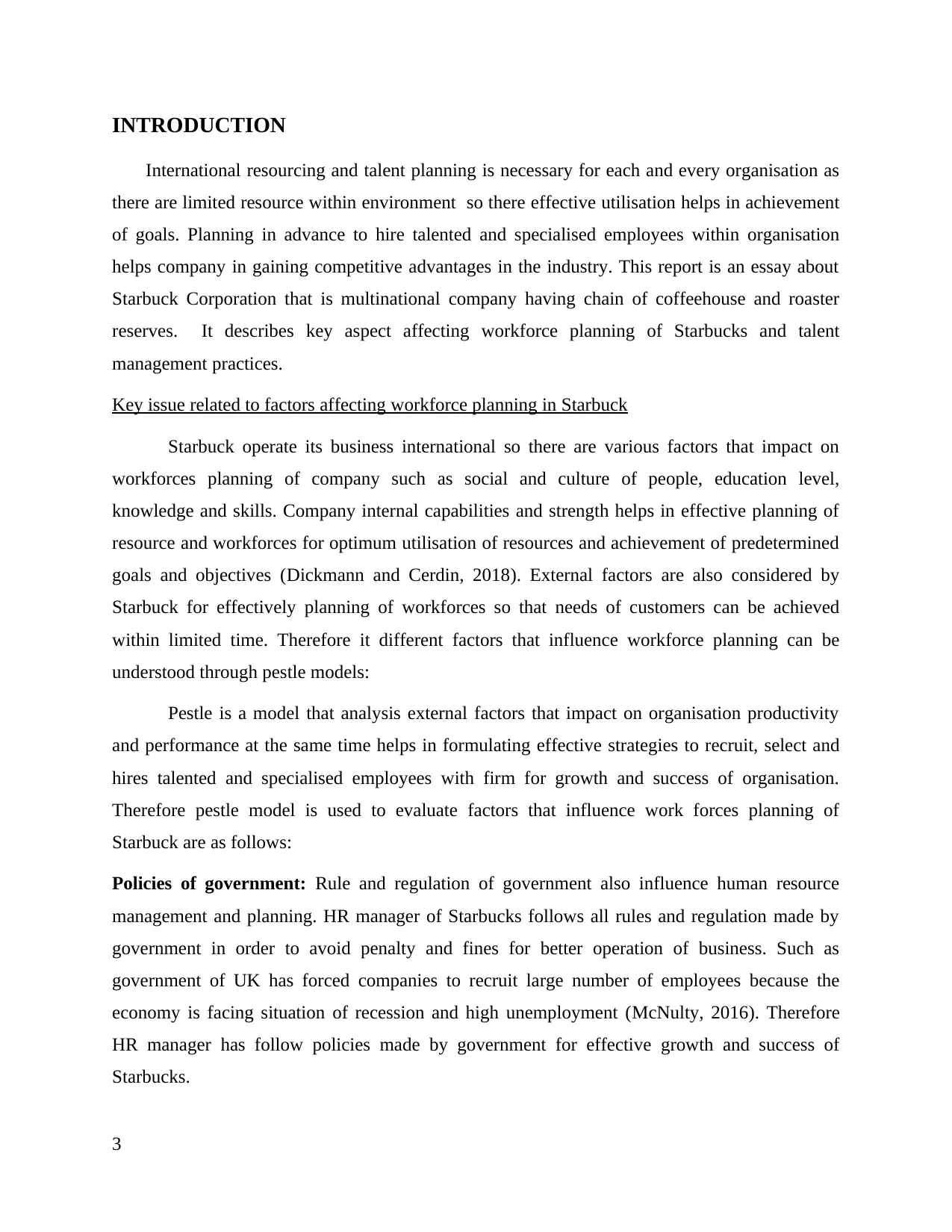
INTRODUCTION
International resourcing and talent planning is necessary for each and every organisation as
there are limited resource within environment so there effective utilisation helps in achievement
of goals. Planning in advance to hire talented and specialised employees within organisation
helps company in gaining competitive advantages in the industry. This report is an essay about
Starbuck Corporation that is multinational company having chain of coffeehouse and roaster
reserves. It describes key aspect affecting workforce planning of Starbucks and talent
management practices.
Key issue related to factors affecting workforce planning in Starbuck
Starbuck operate its business international so there are various factors that impact on
workforces planning of company such as social and culture of people, education level,
knowledge and skills. Company internal capabilities and strength helps in effective planning of
resource and workforces for optimum utilisation of resources and achievement of predetermined
goals and objectives (Dickmann and Cerdin, 2018). External factors are also considered by
Starbuck for effectively planning of workforces so that needs of customers can be achieved
within limited time. Therefore it different factors that influence workforce planning can be
understood through pestle models:
Pestle is a model that analysis external factors that impact on organisation productivity
and performance at the same time helps in formulating effective strategies to recruit, select and
hires talented and specialised employees with firm for growth and success of organisation.
Therefore pestle model is used to evaluate factors that influence work forces planning of
Starbuck are as follows:
Policies of government: Rule and regulation of government also influence human resource
management and planning. HR manager of Starbucks follows all rules and regulation made by
government in order to avoid penalty and fines for better operation of business. Such as
government of UK has forced companies to recruit large number of employees because the
economy is facing situation of recession and high unemployment (McNulty, 2016). Therefore
HR manager has follow policies made by government for effective growth and success of
Starbucks.
3
International resourcing and talent planning is necessary for each and every organisation as
there are limited resource within environment so there effective utilisation helps in achievement
of goals. Planning in advance to hire talented and specialised employees within organisation
helps company in gaining competitive advantages in the industry. This report is an essay about
Starbuck Corporation that is multinational company having chain of coffeehouse and roaster
reserves. It describes key aspect affecting workforce planning of Starbucks and talent
management practices.
Key issue related to factors affecting workforce planning in Starbuck
Starbuck operate its business international so there are various factors that impact on
workforces planning of company such as social and culture of people, education level,
knowledge and skills. Company internal capabilities and strength helps in effective planning of
resource and workforces for optimum utilisation of resources and achievement of predetermined
goals and objectives (Dickmann and Cerdin, 2018). External factors are also considered by
Starbuck for effectively planning of workforces so that needs of customers can be achieved
within limited time. Therefore it different factors that influence workforce planning can be
understood through pestle models:
Pestle is a model that analysis external factors that impact on organisation productivity
and performance at the same time helps in formulating effective strategies to recruit, select and
hires talented and specialised employees with firm for growth and success of organisation.
Therefore pestle model is used to evaluate factors that influence work forces planning of
Starbuck are as follows:
Policies of government: Rule and regulation of government also influence human resource
management and planning. HR manager of Starbucks follows all rules and regulation made by
government in order to avoid penalty and fines for better operation of business. Such as
government of UK has forced companies to recruit large number of employees because the
economy is facing situation of recession and high unemployment (McNulty, 2016). Therefore
HR manager has follow policies made by government for effective growth and success of
Starbucks.
3
⊘ This is a preview!⊘
Do you want full access?
Subscribe today to unlock all pages.

Trusted by 1+ million students worldwide
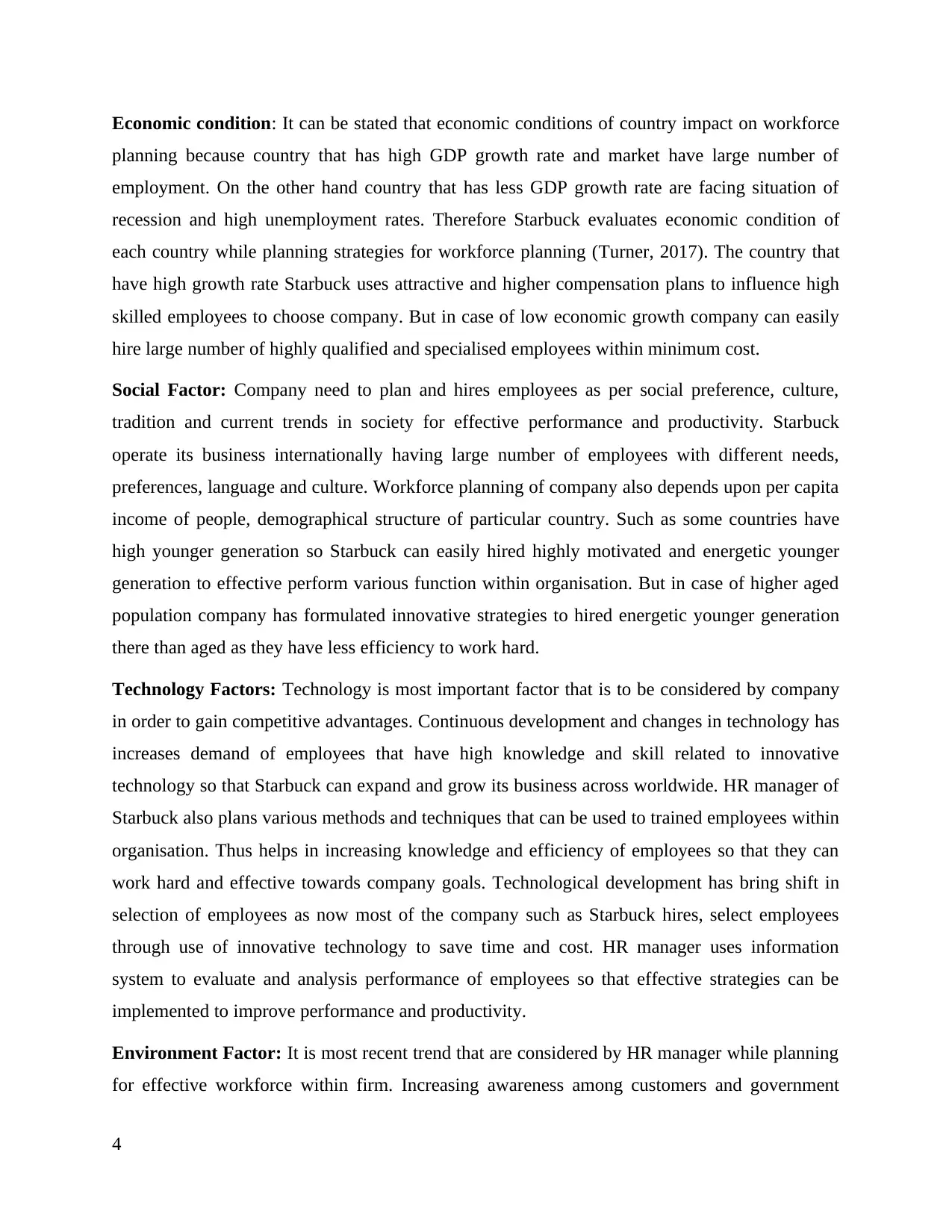
Economic condition: It can be stated that economic conditions of country impact on workforce
planning because country that has high GDP growth rate and market have large number of
employment. On the other hand country that has less GDP growth rate are facing situation of
recession and high unemployment rates. Therefore Starbuck evaluates economic condition of
each country while planning strategies for workforce planning (Turner, 2017). The country that
have high growth rate Starbuck uses attractive and higher compensation plans to influence high
skilled employees to choose company. But in case of low economic growth company can easily
hire large number of highly qualified and specialised employees within minimum cost.
Social Factor: Company need to plan and hires employees as per social preference, culture,
tradition and current trends in society for effective performance and productivity. Starbuck
operate its business internationally having large number of employees with different needs,
preferences, language and culture. Workforce planning of company also depends upon per capita
income of people, demographical structure of particular country. Such as some countries have
high younger generation so Starbuck can easily hired highly motivated and energetic younger
generation to effective perform various function within organisation. But in case of higher aged
population company has formulated innovative strategies to hired energetic younger generation
there than aged as they have less efficiency to work hard.
Technology Factors: Technology is most important factor that is to be considered by company
in order to gain competitive advantages. Continuous development and changes in technology has
increases demand of employees that have high knowledge and skill related to innovative
technology so that Starbuck can expand and grow its business across worldwide. HR manager of
Starbuck also plans various methods and techniques that can be used to trained employees within
organisation. Thus helps in increasing knowledge and efficiency of employees so that they can
work hard and effective towards company goals. Technological development has bring shift in
selection of employees as now most of the company such as Starbuck hires, select employees
through use of innovative technology to save time and cost. HR manager uses information
system to evaluate and analysis performance of employees so that effective strategies can be
implemented to improve performance and productivity.
Environment Factor: It is most recent trend that are considered by HR manager while planning
for effective workforce within firm. Increasing awareness among customers and government
4
planning because country that has high GDP growth rate and market have large number of
employment. On the other hand country that has less GDP growth rate are facing situation of
recession and high unemployment rates. Therefore Starbuck evaluates economic condition of
each country while planning strategies for workforce planning (Turner, 2017). The country that
have high growth rate Starbuck uses attractive and higher compensation plans to influence high
skilled employees to choose company. But in case of low economic growth company can easily
hire large number of highly qualified and specialised employees within minimum cost.
Social Factor: Company need to plan and hires employees as per social preference, culture,
tradition and current trends in society for effective performance and productivity. Starbuck
operate its business internationally having large number of employees with different needs,
preferences, language and culture. Workforce planning of company also depends upon per capita
income of people, demographical structure of particular country. Such as some countries have
high younger generation so Starbuck can easily hired highly motivated and energetic younger
generation to effective perform various function within organisation. But in case of higher aged
population company has formulated innovative strategies to hired energetic younger generation
there than aged as they have less efficiency to work hard.
Technology Factors: Technology is most important factor that is to be considered by company
in order to gain competitive advantages. Continuous development and changes in technology has
increases demand of employees that have high knowledge and skill related to innovative
technology so that Starbuck can expand and grow its business across worldwide. HR manager of
Starbuck also plans various methods and techniques that can be used to trained employees within
organisation. Thus helps in increasing knowledge and efficiency of employees so that they can
work hard and effective towards company goals. Technological development has bring shift in
selection of employees as now most of the company such as Starbuck hires, select employees
through use of innovative technology to save time and cost. HR manager uses information
system to evaluate and analysis performance of employees so that effective strategies can be
implemented to improve performance and productivity.
Environment Factor: It is most recent trend that are considered by HR manager while planning
for effective workforce within firm. Increasing awareness among customers and government
4
Paraphrase This Document
Need a fresh take? Get an instant paraphrase of this document with our AI Paraphraser
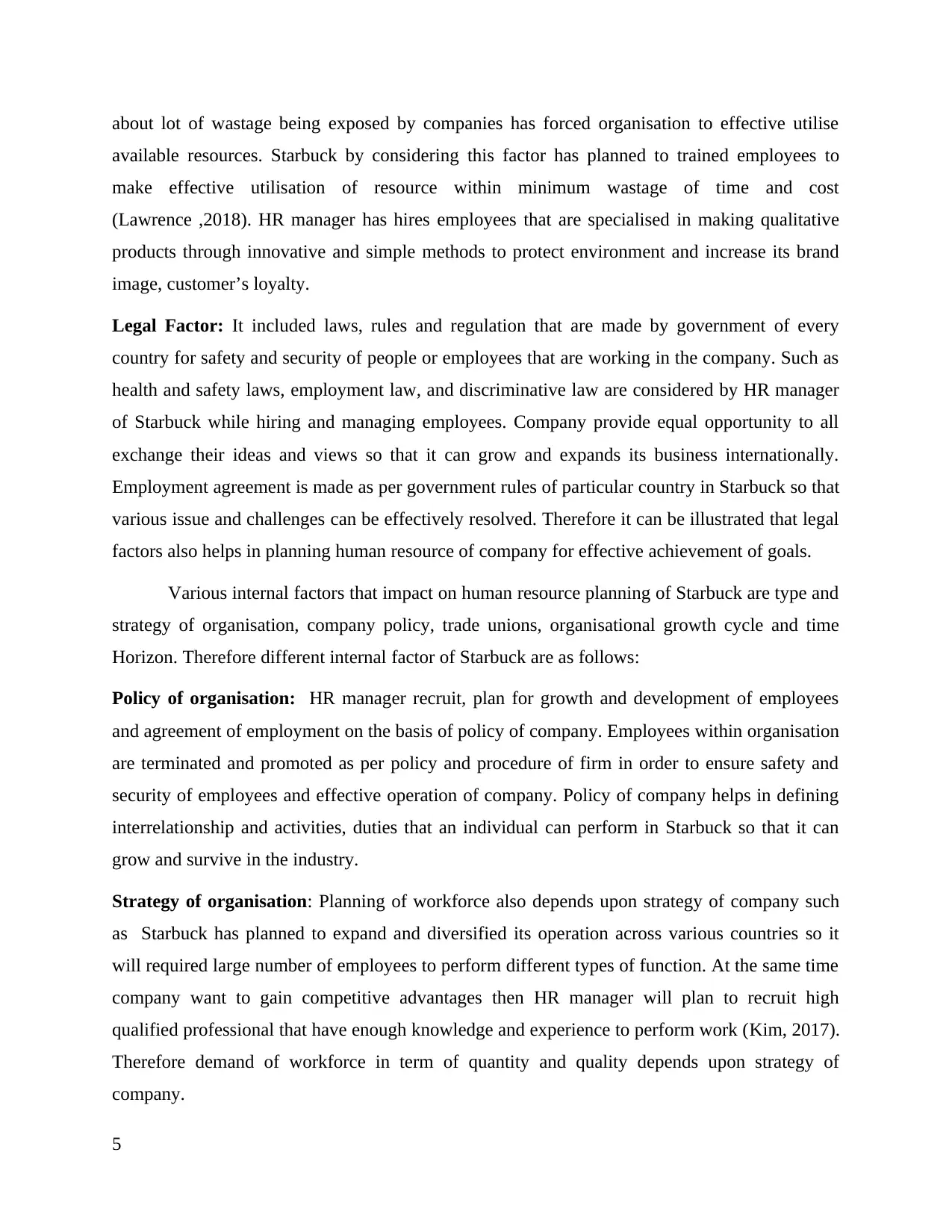
about lot of wastage being exposed by companies has forced organisation to effective utilise
available resources. Starbuck by considering this factor has planned to trained employees to
make effective utilisation of resource within minimum wastage of time and cost
(Lawrence ,2018). HR manager has hires employees that are specialised in making qualitative
products through innovative and simple methods to protect environment and increase its brand
image, customer’s loyalty.
Legal Factor: It included laws, rules and regulation that are made by government of every
country for safety and security of people or employees that are working in the company. Such as
health and safety laws, employment law, and discriminative law are considered by HR manager
of Starbuck while hiring and managing employees. Company provide equal opportunity to all
exchange their ideas and views so that it can grow and expands its business internationally.
Employment agreement is made as per government rules of particular country in Starbuck so that
various issue and challenges can be effectively resolved. Therefore it can be illustrated that legal
factors also helps in planning human resource of company for effective achievement of goals.
Various internal factors that impact on human resource planning of Starbuck are type and
strategy of organisation, company policy, trade unions, organisational growth cycle and time
Horizon. Therefore different internal factor of Starbuck are as follows:
Policy of organisation: HR manager recruit, plan for growth and development of employees
and agreement of employment on the basis of policy of company. Employees within organisation
are terminated and promoted as per policy and procedure of firm in order to ensure safety and
security of employees and effective operation of company. Policy of company helps in defining
interrelationship and activities, duties that an individual can perform in Starbuck so that it can
grow and survive in the industry.
Strategy of organisation: Planning of workforce also depends upon strategy of company such
as Starbuck has planned to expand and diversified its operation across various countries so it
will required large number of employees to perform different types of function. At the same time
company want to gain competitive advantages then HR manager will plan to recruit high
qualified professional that have enough knowledge and experience to perform work (Kim, 2017).
Therefore demand of workforce in term of quantity and quality depends upon strategy of
company.
5
available resources. Starbuck by considering this factor has planned to trained employees to
make effective utilisation of resource within minimum wastage of time and cost
(Lawrence ,2018). HR manager has hires employees that are specialised in making qualitative
products through innovative and simple methods to protect environment and increase its brand
image, customer’s loyalty.
Legal Factor: It included laws, rules and regulation that are made by government of every
country for safety and security of people or employees that are working in the company. Such as
health and safety laws, employment law, and discriminative law are considered by HR manager
of Starbuck while hiring and managing employees. Company provide equal opportunity to all
exchange their ideas and views so that it can grow and expands its business internationally.
Employment agreement is made as per government rules of particular country in Starbuck so that
various issue and challenges can be effectively resolved. Therefore it can be illustrated that legal
factors also helps in planning human resource of company for effective achievement of goals.
Various internal factors that impact on human resource planning of Starbuck are type and
strategy of organisation, company policy, trade unions, organisational growth cycle and time
Horizon. Therefore different internal factor of Starbuck are as follows:
Policy of organisation: HR manager recruit, plan for growth and development of employees
and agreement of employment on the basis of policy of company. Employees within organisation
are terminated and promoted as per policy and procedure of firm in order to ensure safety and
security of employees and effective operation of company. Policy of company helps in defining
interrelationship and activities, duties that an individual can perform in Starbuck so that it can
grow and survive in the industry.
Strategy of organisation: Planning of workforce also depends upon strategy of company such
as Starbuck has planned to expand and diversified its operation across various countries so it
will required large number of employees to perform different types of function. At the same time
company want to gain competitive advantages then HR manager will plan to recruit high
qualified professional that have enough knowledge and experience to perform work (Kim, 2017).
Therefore demand of workforce in term of quantity and quality depends upon strategy of
company.
5
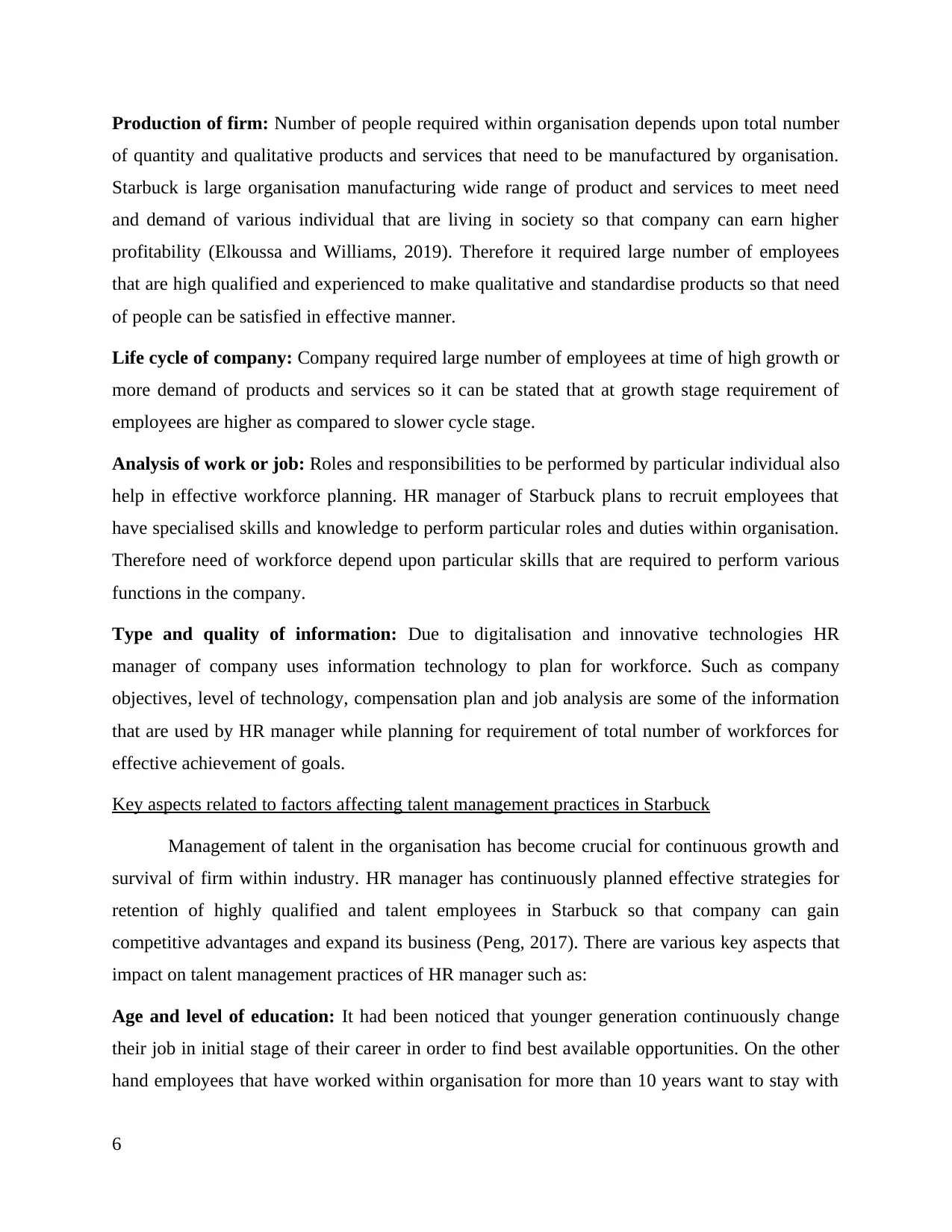
Production of firm: Number of people required within organisation depends upon total number
of quantity and qualitative products and services that need to be manufactured by organisation.
Starbuck is large organisation manufacturing wide range of product and services to meet need
and demand of various individual that are living in society so that company can earn higher
profitability (Elkoussa and Williams, 2019). Therefore it required large number of employees
that are high qualified and experienced to make qualitative and standardise products so that need
of people can be satisfied in effective manner.
Life cycle of company: Company required large number of employees at time of high growth or
more demand of products and services so it can be stated that at growth stage requirement of
employees are higher as compared to slower cycle stage.
Analysis of work or job: Roles and responsibilities to be performed by particular individual also
help in effective workforce planning. HR manager of Starbuck plans to recruit employees that
have specialised skills and knowledge to perform particular roles and duties within organisation.
Therefore need of workforce depend upon particular skills that are required to perform various
functions in the company.
Type and quality of information: Due to digitalisation and innovative technologies HR
manager of company uses information technology to plan for workforce. Such as company
objectives, level of technology, compensation plan and job analysis are some of the information
that are used by HR manager while planning for requirement of total number of workforces for
effective achievement of goals.
Key aspects related to factors affecting talent management practices in Starbuck
Management of talent in the organisation has become crucial for continuous growth and
survival of firm within industry. HR manager has continuously planned effective strategies for
retention of highly qualified and talent employees in Starbuck so that company can gain
competitive advantages and expand its business (Peng, 2017). There are various key aspects that
impact on talent management practices of HR manager such as:
Age and level of education: It had been noticed that younger generation continuously change
their job in initial stage of their career in order to find best available opportunities. On the other
hand employees that have worked within organisation for more than 10 years want to stay with
6
of quantity and qualitative products and services that need to be manufactured by organisation.
Starbuck is large organisation manufacturing wide range of product and services to meet need
and demand of various individual that are living in society so that company can earn higher
profitability (Elkoussa and Williams, 2019). Therefore it required large number of employees
that are high qualified and experienced to make qualitative and standardise products so that need
of people can be satisfied in effective manner.
Life cycle of company: Company required large number of employees at time of high growth or
more demand of products and services so it can be stated that at growth stage requirement of
employees are higher as compared to slower cycle stage.
Analysis of work or job: Roles and responsibilities to be performed by particular individual also
help in effective workforce planning. HR manager of Starbuck plans to recruit employees that
have specialised skills and knowledge to perform particular roles and duties within organisation.
Therefore need of workforce depend upon particular skills that are required to perform various
functions in the company.
Type and quality of information: Due to digitalisation and innovative technologies HR
manager of company uses information technology to plan for workforce. Such as company
objectives, level of technology, compensation plan and job analysis are some of the information
that are used by HR manager while planning for requirement of total number of workforces for
effective achievement of goals.
Key aspects related to factors affecting talent management practices in Starbuck
Management of talent in the organisation has become crucial for continuous growth and
survival of firm within industry. HR manager has continuously planned effective strategies for
retention of highly qualified and talent employees in Starbuck so that company can gain
competitive advantages and expand its business (Peng, 2017). There are various key aspects that
impact on talent management practices of HR manager such as:
Age and level of education: It had been noticed that younger generation continuously change
their job in initial stage of their career in order to find best available opportunities. On the other
hand employees that have worked within organisation for more than 10 years want to stay with
6
⊘ This is a preview!⊘
Do you want full access?
Subscribe today to unlock all pages.

Trusted by 1+ million students worldwide
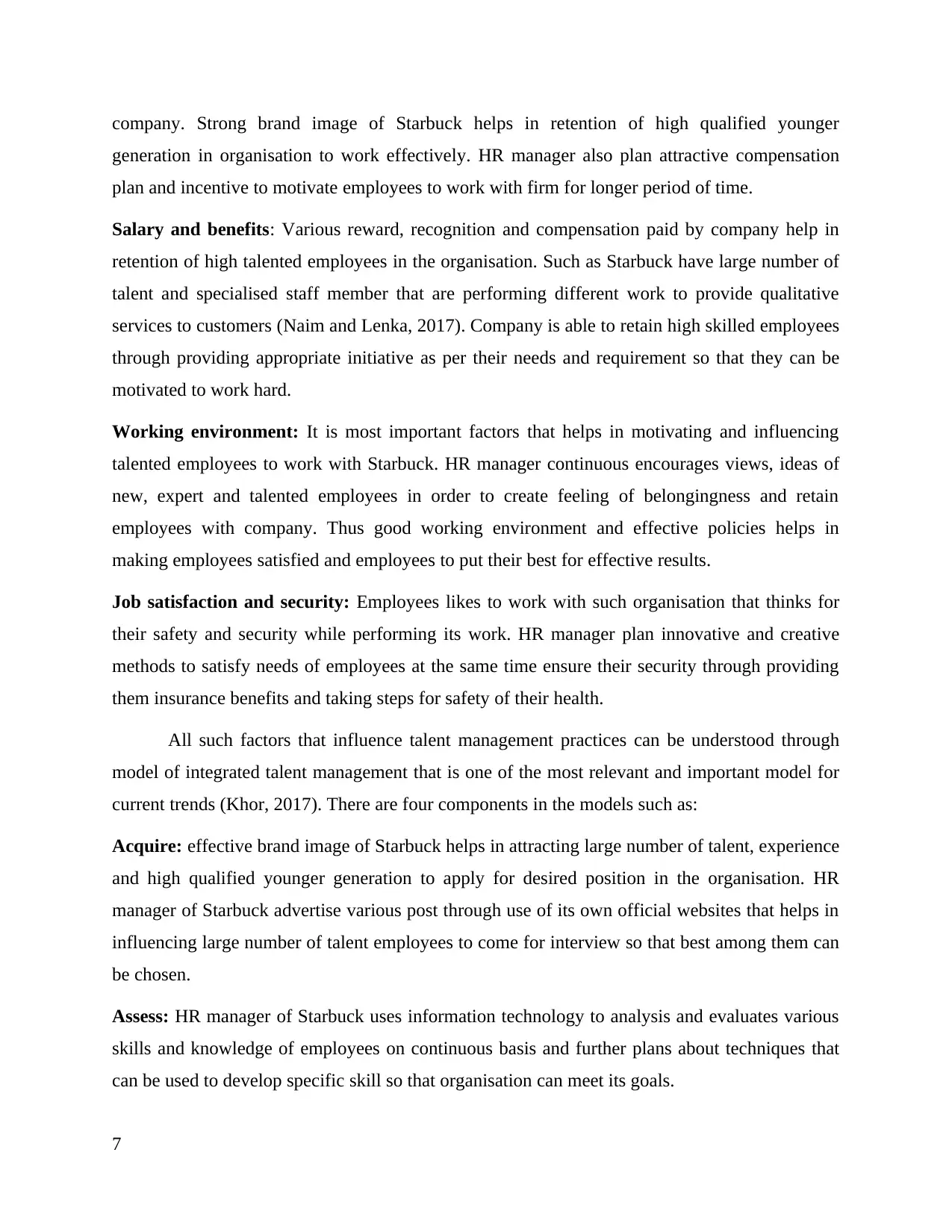
company. Strong brand image of Starbuck helps in retention of high qualified younger
generation in organisation to work effectively. HR manager also plan attractive compensation
plan and incentive to motivate employees to work with firm for longer period of time.
Salary and benefits: Various reward, recognition and compensation paid by company help in
retention of high talented employees in the organisation. Such as Starbuck have large number of
talent and specialised staff member that are performing different work to provide qualitative
services to customers (Naim and Lenka, 2017). Company is able to retain high skilled employees
through providing appropriate initiative as per their needs and requirement so that they can be
motivated to work hard.
Working environment: It is most important factors that helps in motivating and influencing
talented employees to work with Starbuck. HR manager continuous encourages views, ideas of
new, expert and talented employees in order to create feeling of belongingness and retain
employees with company. Thus good working environment and effective policies helps in
making employees satisfied and employees to put their best for effective results.
Job satisfaction and security: Employees likes to work with such organisation that thinks for
their safety and security while performing its work. HR manager plan innovative and creative
methods to satisfy needs of employees at the same time ensure their security through providing
them insurance benefits and taking steps for safety of their health.
All such factors that influence talent management practices can be understood through
model of integrated talent management that is one of the most relevant and important model for
current trends (Khor, 2017). There are four components in the models such as:
Acquire: effective brand image of Starbuck helps in attracting large number of talent, experience
and high qualified younger generation to apply for desired position in the organisation. HR
manager of Starbuck advertise various post through use of its own official websites that helps in
influencing large number of talent employees to come for interview so that best among them can
be chosen.
Assess: HR manager of Starbuck uses information technology to analysis and evaluates various
skills and knowledge of employees on continuous basis and further plans about techniques that
can be used to develop specific skill so that organisation can meet its goals.
7
generation in organisation to work effectively. HR manager also plan attractive compensation
plan and incentive to motivate employees to work with firm for longer period of time.
Salary and benefits: Various reward, recognition and compensation paid by company help in
retention of high talented employees in the organisation. Such as Starbuck have large number of
talent and specialised staff member that are performing different work to provide qualitative
services to customers (Naim and Lenka, 2017). Company is able to retain high skilled employees
through providing appropriate initiative as per their needs and requirement so that they can be
motivated to work hard.
Working environment: It is most important factors that helps in motivating and influencing
talented employees to work with Starbuck. HR manager continuous encourages views, ideas of
new, expert and talented employees in order to create feeling of belongingness and retain
employees with company. Thus good working environment and effective policies helps in
making employees satisfied and employees to put their best for effective results.
Job satisfaction and security: Employees likes to work with such organisation that thinks for
their safety and security while performing its work. HR manager plan innovative and creative
methods to satisfy needs of employees at the same time ensure their security through providing
them insurance benefits and taking steps for safety of their health.
All such factors that influence talent management practices can be understood through
model of integrated talent management that is one of the most relevant and important model for
current trends (Khor, 2017). There are four components in the models such as:
Acquire: effective brand image of Starbuck helps in attracting large number of talent, experience
and high qualified younger generation to apply for desired position in the organisation. HR
manager of Starbuck advertise various post through use of its own official websites that helps in
influencing large number of talent employees to come for interview so that best among them can
be chosen.
Assess: HR manager of Starbuck uses information technology to analysis and evaluates various
skills and knowledge of employees on continuous basis and further plans about techniques that
can be used to develop specific skill so that organisation can meet its goals.
7
Paraphrase This Document
Need a fresh take? Get an instant paraphrase of this document with our AI Paraphraser
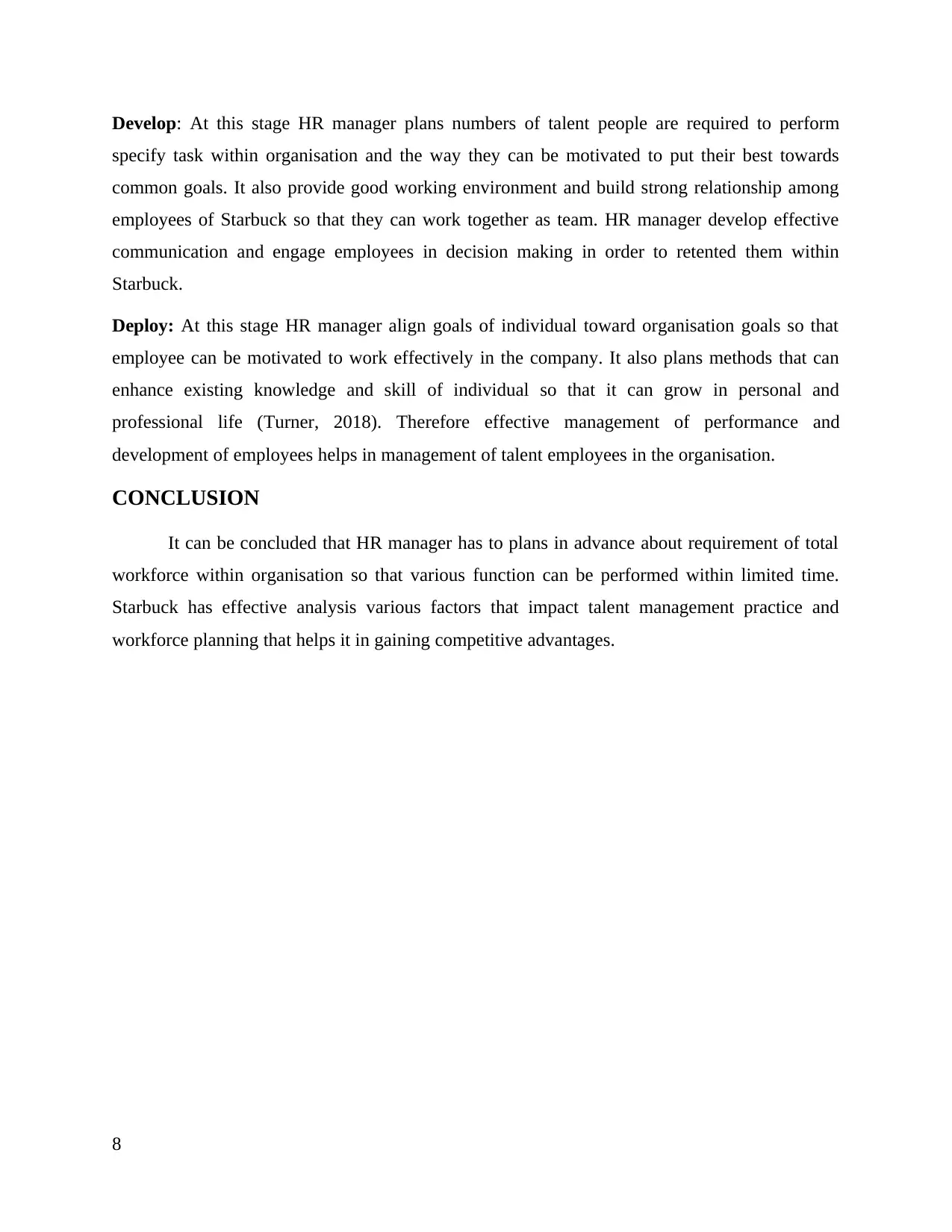
Develop: At this stage HR manager plans numbers of talent people are required to perform
specify task within organisation and the way they can be motivated to put their best towards
common goals. It also provide good working environment and build strong relationship among
employees of Starbuck so that they can work together as team. HR manager develop effective
communication and engage employees in decision making in order to retented them within
Starbuck.
Deploy: At this stage HR manager align goals of individual toward organisation goals so that
employee can be motivated to work effectively in the company. It also plans methods that can
enhance existing knowledge and skill of individual so that it can grow in personal and
professional life (Turner, 2018). Therefore effective management of performance and
development of employees helps in management of talent employees in the organisation.
CONCLUSION
It can be concluded that HR manager has to plans in advance about requirement of total
workforce within organisation so that various function can be performed within limited time.
Starbuck has effective analysis various factors that impact talent management practice and
workforce planning that helps it in gaining competitive advantages.
8
specify task within organisation and the way they can be motivated to put their best towards
common goals. It also provide good working environment and build strong relationship among
employees of Starbuck so that they can work together as team. HR manager develop effective
communication and engage employees in decision making in order to retented them within
Starbuck.
Deploy: At this stage HR manager align goals of individual toward organisation goals so that
employee can be motivated to work effectively in the company. It also plans methods that can
enhance existing knowledge and skill of individual so that it can grow in personal and
professional life (Turner, 2018). Therefore effective management of performance and
development of employees helps in management of talent employees in the organisation.
CONCLUSION
It can be concluded that HR manager has to plans in advance about requirement of total
workforce within organisation so that various function can be performed within limited time.
Starbuck has effective analysis various factors that impact talent management practice and
workforce planning that helps it in gaining competitive advantages.
8
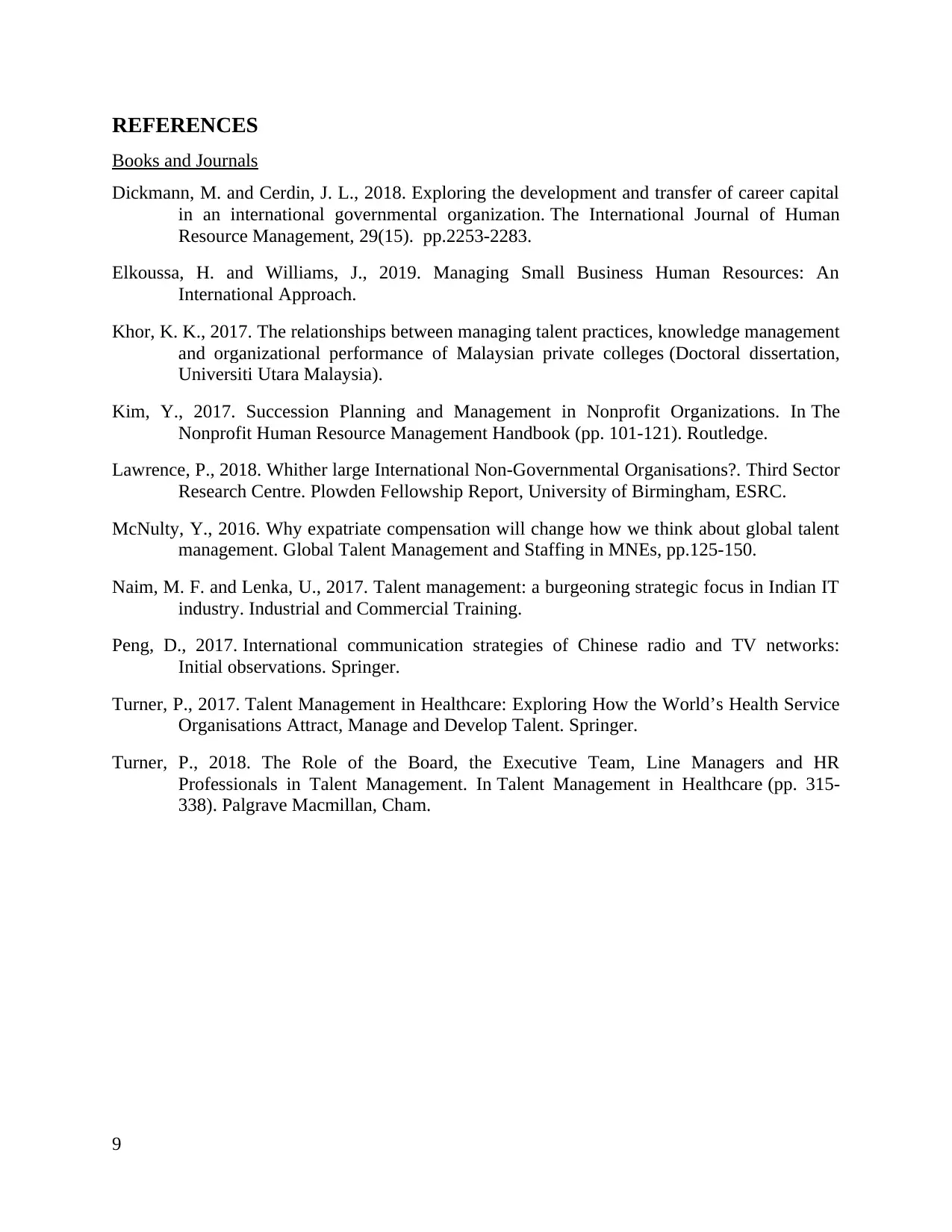
REFERENCES
Books and Journals
Dickmann, M. and Cerdin, J. L., 2018. Exploring the development and transfer of career capital
in an international governmental organization. The International Journal of Human
Resource Management, 29(15). pp.2253-2283.
Elkoussa, H. and Williams, J., 2019. Managing Small Business Human Resources: An
International Approach.
Khor, K. K., 2017. The relationships between managing talent practices, knowledge management
and organizational performance of Malaysian private colleges (Doctoral dissertation,
Universiti Utara Malaysia).
Kim, Y., 2017. Succession Planning and Management in Nonprofit Organizations. In The
Nonprofit Human Resource Management Handbook (pp. 101-121). Routledge.
Lawrence, P., 2018. Whither large International Non-Governmental Organisations?. Third Sector
Research Centre. Plowden Fellowship Report, University of Birmingham, ESRC.
McNulty, Y., 2016. Why expatriate compensation will change how we think about global talent
management. Global Talent Management and Staffing in MNEs, pp.125-150.
Naim, M. F. and Lenka, U., 2017. Talent management: a burgeoning strategic focus in Indian IT
industry. Industrial and Commercial Training.
Peng, D., 2017. International communication strategies of Chinese radio and TV networks:
Initial observations. Springer.
Turner, P., 2017. Talent Management in Healthcare: Exploring How the World’s Health Service
Organisations Attract, Manage and Develop Talent. Springer.
Turner, P., 2018. The Role of the Board, the Executive Team, Line Managers and HR
Professionals in Talent Management. In Talent Management in Healthcare (pp. 315-
338). Palgrave Macmillan, Cham.
9
Books and Journals
Dickmann, M. and Cerdin, J. L., 2018. Exploring the development and transfer of career capital
in an international governmental organization. The International Journal of Human
Resource Management, 29(15). pp.2253-2283.
Elkoussa, H. and Williams, J., 2019. Managing Small Business Human Resources: An
International Approach.
Khor, K. K., 2017. The relationships between managing talent practices, knowledge management
and organizational performance of Malaysian private colleges (Doctoral dissertation,
Universiti Utara Malaysia).
Kim, Y., 2017. Succession Planning and Management in Nonprofit Organizations. In The
Nonprofit Human Resource Management Handbook (pp. 101-121). Routledge.
Lawrence, P., 2018. Whither large International Non-Governmental Organisations?. Third Sector
Research Centre. Plowden Fellowship Report, University of Birmingham, ESRC.
McNulty, Y., 2016. Why expatriate compensation will change how we think about global talent
management. Global Talent Management and Staffing in MNEs, pp.125-150.
Naim, M. F. and Lenka, U., 2017. Talent management: a burgeoning strategic focus in Indian IT
industry. Industrial and Commercial Training.
Peng, D., 2017. International communication strategies of Chinese radio and TV networks:
Initial observations. Springer.
Turner, P., 2017. Talent Management in Healthcare: Exploring How the World’s Health Service
Organisations Attract, Manage and Develop Talent. Springer.
Turner, P., 2018. The Role of the Board, the Executive Team, Line Managers and HR
Professionals in Talent Management. In Talent Management in Healthcare (pp. 315-
338). Palgrave Macmillan, Cham.
9
⊘ This is a preview!⊘
Do you want full access?
Subscribe today to unlock all pages.

Trusted by 1+ million students worldwide
1 out of 9
Related Documents
Your All-in-One AI-Powered Toolkit for Academic Success.
+13062052269
info@desklib.com
Available 24*7 on WhatsApp / Email
![[object Object]](/_next/static/media/star-bottom.7253800d.svg)
Unlock your academic potential
Copyright © 2020–2025 A2Z Services. All Rights Reserved. Developed and managed by ZUCOL.




